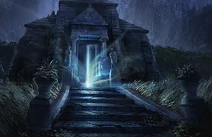No edit summary Tag: sourceedit |
No edit summary Tag: sourceedit |
||
| Line 8: | Line 8: | ||
|Appearance = A clingy, possessive spirit... |
|Appearance = A clingy, possessive spirit... |
||
|image=File:Dybbuk-437476.jpg |
|image=File:Dybbuk-437476.jpg |
||
| + | |caption="What is this affliction that clings to me???"}} |
||
| − | |caption=}} |
||
Revision as of 06:23, 4 June 2015
Origins
The Dybbuk is a creature with origins in Jewish mythology, legend and folklore. In particular, it is believed that accounts of its existence first arise within writings from the 16th century.
The name 'Dybbuk' is actually a shortening of the phrase "דיבבוק מערו'אַח ראַ'אַה" (dibbuk me-ru'aḥ ra'ah, meaning "a cleavage of an evil spirit") or according to some, of the phrase dibbuk min ha-hiẓonim ("dibbuk from the outside").
However, the term did not come into more popular use among scholars until the S. Ansky play of the same name.
The existence of such a spirit helped to advocate for more orthodox shows of Jewish faith, for it was said that a sloppily made mezuzah, doubt of Moses' parting the Red Sea, or any other sign of lacking devotion to the Jewish tradition, was a potential invitation to be possessed by a Dybbuk.
This often leads to confusion among scholars: some believe that it is a demon, while others think it no more than the spirit of a deceased person, fleeing the justice of punishment in the afterlife.
Appearance
A Dybbuk's appearance is perhaps among its most disturbing traits. While many malevolent spirits remain invisible or take on the form of some hideous monster, the Dybbuk looks very much like a human.
In fact, it often resembles a person familiar to the community it invades; perhaps a beloved pillar of the community, a neighbor or relative of the person it attacks, or a close friend or even a lost love.
Their expression is often one of intense and permanent anger, despair or deep, longing loneliness.

